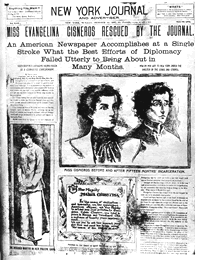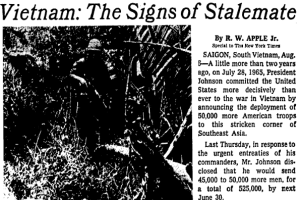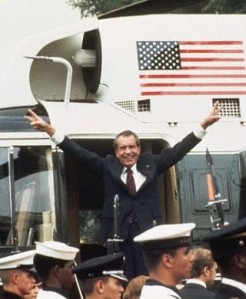Media Myth Alert directed attention periodically in 2021 to the appearance of well-known media-driven myths, those prominent tales about and/or by the news media that are widely believed and often retold but which, under scrutiny, dissolve as apocryphal or wildly exaggerated.
Here’s a look at the year’s five top posts at Media Myth Alert, a year that featured the media’s retelling a variety of dubious tales.
■ Watergate myth, extravagant version: Press ‘dethroned’ Nixon (posted April 24): The dominant narrative of the Watergate scandal — the signal crime of which took place nearly 50 years ago — has it that dogged reporting by Bob Woodward and Carl Bernstein of the Washington Post uncovered the crimes that brought down Richard Nixon’s corrupt presidency.

Nixon, before being ‘dethroned’
That I call the heroic-journalist interpretation of Watergate and it lives on as a mythical and irresistible fillip to journalists seeking inspiration amid the gloom pervasive in their field.
Rarely has the Watergate myth been presented as extravagantly as it was in an Esquire UK essay pegged to the 45th anniversary of the release of All the President’s Men, the movie that did much to embed the heroic-journalist trope in popular consciousness.
“It’s easy to romantici[z]e a time when people bought newspapers and presidents could be shamed,” the essay stated. “We think of simpler as better. Which is perhaps why, on its 45th anniversary, All the President’s Men, is ostensibly heralded as something of a shiny art[i]fact from an even shinier era.
“Because back then, presidents couldn’t only be shamed by the free-ish and fair-ish press, but dethroned entirely – a rare event that serves as the true life narrative backbone of All the President’s Men as it retells the Watergate scandal and The Washington Post reporters behind its excavation.”
Dethroned entirely? Heh.

All the President’s Men, the movie
Of course that’s not what happened in Watergate. Forces far more powerful than Woodward and Bernstein and the Washington Post brought about the fall of Nixon’s corrupt presidency.
As I wrote in the media-mythbusting book, Getting It Wrong, breaking open the Watergate scandal “required the collective if not always the coordinated forces of special prosecutors, federal judges, both houses of Congress, and the Supreme Court, as well as the Justice Department and the FBI.”
Even then, I noted, “Nixon likely would have served out his term if not for the audiotape recordings he secretly made of most conversations in the Oval Office of the White House. Only when compelled by the Supreme Court did Nixon surrender those recordings, which captured him plotting the cover-up” of the foiled break-in at Democratic National Headquarters in June 1972.
It is, moreover, instructive to remember what Woodward has said about Watergate. He told an interviewer in 2004, 30 years after Nixon resigned:
“To say that the press brought Nixon, that’s horseshit.”

PBS’ Hearst: uneddifying portrait
■ PBS’ ‘easy caricature’ of media mogul Hearst (posted September 28): PBS documentaries are nothing if not uneven. The public broadcaster seldom hesitates to make clear which subjects it favors and which it deplores.
Fair-minded the documentaries tend not to be.
For example, the tyrannical publisher Joseph Pulitzer received fawning PBS treatment a couple of years ago, while his younger, late 19th century rival, William Randolph Hearst, was the subject of an unedifying, two-part documentary that was long on stereotype and short on fresh insight.
PBS presented Hearst essentially as a profligate rich kid who never quite grew up, who loved hi-jinks and fireworks, and possessed scant commitment to truth-telling in journalism.
Such assessments, I noted, “have been around for decades, promoted by a succession of bad biographies such as Ferdinand Lundberg’s polemical Imperial Hearst in 1936 and W.A. Swanberg’s dreadful Citizen Hearst in 1961. A more considered and even-handed treatment of Hearst was offered in David Nasaw’s The Chief, which came out in 2000.”
So it was rather odd that the PBS documentary pressed the frivolous rich-kid theme, given that it claimed to be “based on” Nasaw’s biography. And Nasaw was shown in the film frequently, offering comments about Hearst. (He was the sole Hearst biographer among the program’s several talking heads, nearly all of whom seemed eager to describe Hearst in unflattering terms.)
It was as if PBS producers settled on the frivolous rich-kid theme and ignored evidence of Hearst as a complex and innovative character whose journalism — especially his “yellow journalism” or “journalism of action” of the late 19th century — defied easy caricature.
The PBS portrait was at times tedious, and often gossipy. It emphasized Hearst’s flamboyance but regarded it as frivolous.
Hearst was flamboyant. But he and his journalism were scarcely frivolous.
■ Botched Afghanistan withdrawal was ‘Biden’s Katrina’? (posted August 27): The death and chaos that accompanied Joe Biden’s botched and precipitous withdrawal of U.S. military personnel from Afghanistan was likened to a kind of Hurricane Katrina for the president.

Misreporting Katrina, 2005
The allusion was to the damage done to President George W. Bush’s administration by its fitful federal response to the hurricane that tore into the U.S. Gulf Coast in late summer 2005, leaving much of New Orleans under water.
While faintly interesting, the analogy was cliched and badly misplaced: the hasty and unprovoked flight that Biden ordered from Afghanistan after a 20-year military commitment there, and the country’s swift takeover by Taliban extremists, was a foreign policy debacle of towering dimension.
The Afghanistan withdrawal was hardly “Biden’s Katrina.” It was scandalously worse.
Katrina was a powerful, destructive natural disaster, the aftermath of which was badly misreported. The dominant media narrative in late summer 2005 told of mayhem and unimaginable horror supposedly unleashed across New Orleans.
But as I discussed in Getting It Wrong, much of the reporting about Katrina’s aftermath — the horror, the anarchy, the city’s social disintegration — was highly exaggerated and erroneous. Few if any of the nightmarish accounts that coursed through the media proved true.
The U.S. exit from Afghanistan, on the other hand, was a bloody, self-inflicted disaster, borne of Biden’s blundering and impatience.
Hundreds of Americans and their Afghan allies were stranded as Biden’s ill-planned withdrawal effectively turned Afghanistan over to the Taliban and undid years of effort to stabilize the country where the deadly terrorist attacks of September 11, 2001, were plotted.
The president’s ineptitude brought reminders of the devastating observation by former defense secretary Robert Gates who, in a memoir published in 2014, wrote that Biden had “been wrong on nearly every major foreign policy and national security issue over the past four decades.”
■ Challenging the mantra that 9/11 ‘changed everything’ (posted September 10): From the first hours after the terrorist attacks of September 11, 2001, news outlets have promoted a mantra that the assault on commercial and military landmarks in New York and suburban Washington “changed everything” in America.
To posit that 9/11 “changed everything” has been a way to make fathomable the shock, horror, and grim theatricality of that infamous day, a way to invest September 11, 2001, with exceptional and enduring significance.
But exactly what “changed everything” meant has remained definitionally elusive — and subject to dispute. “Nothing changes everything,” columnist George Will wrote at the fifth anniversary of 9/11. (The activist Jesse Jackson said at the first anniversary that “9/11 did not change everything. It did change the subject.”)
 In September, at the 20th anniversary of the attacks, the Washington Post determinedly took up the “changed everything” mantra. It devoted much of its Sunday magazine (see cover image nearby) to a collection of brief, solicited opinions purporting to describe how 9/11 wrought change in journalism, television, movies, art, fashion, theater, policing, architecture, editorial cartooning, and other fields and pursuits.
In September, at the 20th anniversary of the attacks, the Washington Post determinedly took up the “changed everything” mantra. It devoted much of its Sunday magazine (see cover image nearby) to a collection of brief, solicited opinions purporting to describe how 9/11 wrought change in journalism, television, movies, art, fashion, theater, policing, architecture, editorial cartooning, and other fields and pursuits.
The collection was introduced with a sweeping claim that “9/11 changed the world in demonstrable, massive and heartbreaking ways.” But it ultimately was a superficial and unpersuasive attempt to support and bring dimension to the “changed everything” catchcry.
Indeed, it was striking how the Post’s collection presented at best mixed evidence of significant change incontrovertibly linked to the attacks. Many of its entries were impressionistic. Or vague. Or both.
Here, for example, is one puzzling contribution: “The post-9/11 fashion industry puts a premium on fresh faces and wily entrepreneurs. And while those celebrated young talents often move with reckless speed, the desire to create and a belief in the impossible were salvaged from the wreckage.”
The attacks of 9/11 certainly led to change — and fresh intrusions — in airport security and personal privacy. The reach of the federal government was expanded. The country went to war in Afghanistan.
But when considered closely, it is quite clear that the 9/11 attacks did not “change everything.”
They were not fatal to American political or economic power. Public opinion polls taken after 9/11 found that many Americans sensed a surge of patriotic fervor, a deeper commitment to the religious and spiritual side of life, and a newfound sense of political unity.
Such responses, however, proved fleeting. Given time, they faded.
■ The impressive and enduring appeal of journalism’s most famous jailbreak narrative (posted May 29): The remarkable and enduring appeal of American journalism’s most famous jailbreak narrative — the escape of Evangelina Cisneros from a Havana prison in October 1897 — was demonstrated anew in 2021.
The jailbreak, which was organized by a Havana-based reporter for William Randolph Hearst’s brash New York Journal, was the centerpiece of the third treatment by a novelist since the early 1990s.

Jail-breaking journalism, 1897
The escape of Cisneros, then a teenage political prisoner, represented the zenith of Hearst’s “journalism of action,” a paradigm that envisioned newspapers taking high-profile participatory roles in addressing, and remedying, wrongs of society.
The jailbreak was central to Chanel Cleeton’s The Most Beautiful Girl in Cuba, which was published in May. It also was a narrative centerpiece of Daniel Lynch’s amusing if improbable Yellow, which came out in 1992, and of Amy Ephron’s White Rose, which was published in 1999 and billed as part romance, part thriller.
I read portions of Cleeton’s novel and was struck to find that it included details first described in my 2006 book, The Year That Defined American Journalism: 1897 and the Clash of Paradigms. (I also reported findings about the jailbreak in an article, “Not a Hoax: New Evidence in the New York Journal’s Rescue of Evangelina Cisneros,” that was published in 2002 in the peer-reviewed scholarly journal American Journalism.)
Cleeton, however, acknowledged no debt to The Year That Defined American Journalism, which rejected the persistent but evidence-thin notion that the jailbreak was a hoax, that Cisneros was freed because Spanish authorities then ruling Cuba had been bribed to look the other way.
As I wrote in The Year That Defined American Journalism, the Cisneros jailbreak was “the successful result of an intricate plot in which Cuba-based operatives and U.S. diplomatic personnel filled vital roles” — roles that had remained obscure for more than 100 years.
To her credit, Cleeton did not embrace the jailbreak-as-hoax notion.
But her discussion of the main actors who conspired to break Cisneros from jail would be familiar to readers of The Year That Defined American Journalism.
Given her novel’s reliance on details first published in The Year That Defined American Journalism, Cleeton’s acknowledging the book by title would have been appropriate. And appreciated.
Other memorable posts of 2021:
- Media myth alert at 12: Recalling memorable myth-busting posts
- An international dimension to prominent media myths
- Hal Holbrook, ‘follow the money,’ and Watergate’s distorted history
- ‘Such was Cronkite’s influence’
- Punctured tale of Trump’s photo op may live on as media myth
- Insidious: Off-hand references signal deep embedding of prominent media myths
 Twelve years offers a fitting occasion to recall some memorable posts — posts that tweaked
Twelve years offers a fitting occasion to recall some memorable posts — posts that tweaked 
 Obama defeated Romney by an electoral count of 332-206.
Obama defeated Romney by an electoral count of 332-206.




 E&P, as it’s called, traces its pedigree to the late 19th century but is hardly much of a force these days. It nearly went out of business 12 years or so ago and more recently was
E&P, as it’s called, traces its pedigree to the late 19th century but is hardly much of a force these days. It nearly went out of business 12 years or so ago and more recently was 
 “Days that live in infamy are supposed to be found in dusty history books. Tuesday changed all that. It
“Days that live in infamy are supposed to be found in dusty history books. Tuesday changed all that. It  The Washington Post made a determined effort recently to pin down and elaborate on the “changed everything” mantra. It did so by devoting much of its Sunday magazine (see cover image nearby) to a
The Washington Post made a determined effort recently to pin down and elaborate on the “changed everything” mantra. It did so by devoting much of its Sunday magazine (see cover image nearby) to a 





